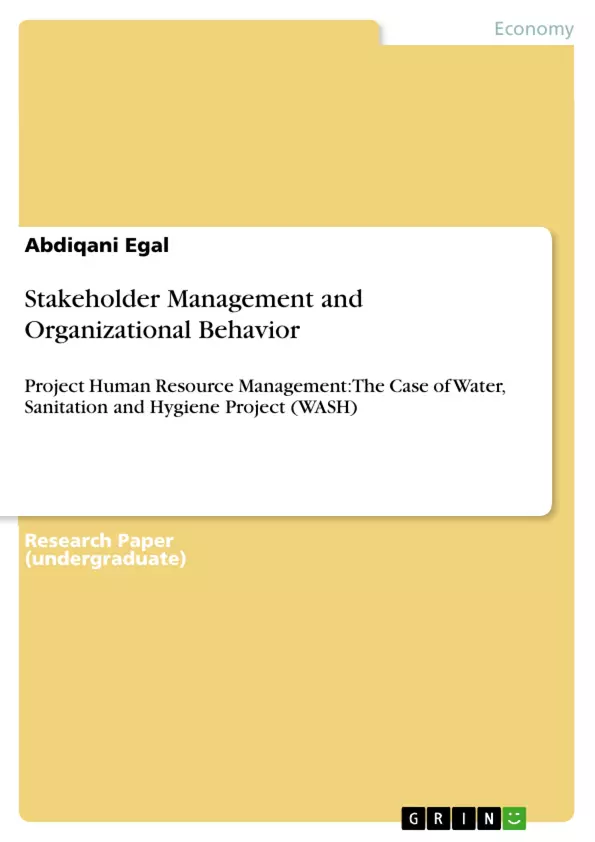The project Human resource management is the major element that affects the project
success and failure. It is an enabling processes that facilitates to the accomplishment of
balanced project deliverable objectives of scope, time, cost and quality through
integrating all of the project management body of knowledge areas. This is because of
other project management processes were done by people and therefore they reflect
the level of competency of the project staff. Infect the level of project acquired staff will
affect the project baseline schedule and therefore the project cost and performance.
The project personnel improve the triumph of project performance through teamwork.
Hence, this brief essay highlights the impact of the project team on the project
performance. It will acquire all project management family the understanding of what
role do the project human resource plays in the performance of modern project based
management. It describes with the practical case study of Water sanitation and Hygiene
development project.
Inhaltsverzeichnis (Table of Contents)
- Introduction
- Description of the Essay
- Literature Review
- Organizational Theory and Design
- Classical Organizational Theory
- Scientific Management Concept
- Administrative Principals
- Bureaucratic Approach
- Neo-Classical Organizational Theory
- Contemporary Organizational Theory
- Contingency Organizational Theory
- Classical Organizational Theory
- Organizational Structure
- Functional Organization.
- Pure Organization.
- Matrix Organizations.
- Project Human Resource Management Processes
- The Impact of Human Resource management on Project Performance
- CARE International Somalia Organizational Structure and Human Resource Policy
- Organizational Theory and Design
- Human Resource Management processes of Water, Sanitation and
Hygiene (WASH) Project
- Water Sanitation and Hygiene Project Organizational Structure
- Responsibility Assignment Matrix (RAM) of Water, Sanitation and Hygiene (WASH) Project
- Organizational Responsibility Chart.
- The Impact of Human Resource management on WASH Project performance
- Water Sanitation and Hygiene Project Organizational Structure
- Conclusion and Recommendations
Zielsetzung und Themenschwerpunkte (Objectives and Key Themes)
This essay focuses on the importance of project human resource management for successful project implementation, using the Water, Sanitation and Hygiene (WASH) project as a case study. It examines the impact of human resource management on project performance, particularly in the context of organizational structure and competency.
- The significance of project human resource management in achieving project objectives.
- The role of organizational theory and design in influencing project team performance.
- The impact of organizational structure and competency on project success.
- The practical application of project human resource management principles in the WASH project.
- The relationship between project human resource management and project performance.
Zusammenfassung der Kapitel (Chapter Summaries)
- Introduction: This chapter defines project management and emphasizes the critical role of people in project success. It introduces the concept of project human resource management and its importance in achieving project objectives.
- Literature Review: This chapter delves into organizational theory and design, covering classical, neo-classical, and contemporary approaches. It explores various organizational structures, including functional, pure, and matrix organizations, and their impact on project performance.
- Project Human Resource Management Processes: This chapter examines the impact of human resource management on project performance. It highlights the significance of staff competency, work breakdown structure, and organizational assignment matrix in ensuring project success.
- CARE International Somalia Organizational Structure and Human Resource Policy: This chapter provides an overview of CARE International Somalia's organizational structure and human resource policies, setting the context for the WASH project case study.
- Human Resource Management processes of Water, Sanitation and Hygiene (WASH) Project: This chapter examines the WASH project's organizational structure, including the responsibility assignment matrix and organizational responsibility chart. It analyzes the impact of human resource management on the project's performance.
Schlüsselwörter (Keywords)
Project human resource management, organizational theory and design, project performance, organizational structure, competency, WASH project, CARE International Somalia, responsibility assignment matrix, organizational responsibility chart.
- Citar trabajo
- Abdiqani Egal (Autor), 2012, Stakeholder Management and Organizational Behavior, Múnich, GRIN Verlag, https://www.grin.com/document/198785



